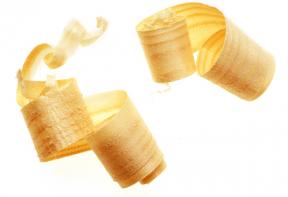Cabinet scraper how-to
Try this alternative to sanding on your next carpentry project
Essentially a flat piece of steel with a sharp burr formed on the edge, a cabinet scraper removes shavings of wood rather than grinding it into fine sawdust as sandpaper does.
Back before the invention of sandpaper, craftsmen would scrape the surface of wood to get it smooth. Thankfully, cabinet scrapers have stood the test of time and are still available today. One of the most inexpensive tools to buy, scrapers leave a silky-smooth surface superior to even the finest grits of sandpaper. They also work faster than sandpaper.
In order for a scraper to work, you need to form–or burnish–a hooked edge to cut the wood fibres. To accomplish this, first polish the scraper’s edge at 90º using either a fine whetstone or 1,000-grit sandpaper on a flat surface.
Once the square edge is polished, form the hook by running a smooth hard tool over each corner at a slight angle. Any smooth hard metal will work for this, so long as it is made of harder steel than the scraper itself. The shaft of a good screwdriver or the shaft of a router bit works quite well. (I like to use the base of a 1/2″ solid-carbide spiral bit.)
The three main ways to use a scraper
 Push method: This is the most aggressive method of scraping. A bow is formed in the scraper by pushing the centre out with your thumbs, and the scraper is pushed into the wood. This is the most popular approach, as it yields the fastest results.
Push method: This is the most aggressive method of scraping. A bow is formed in the scraper by pushing the centre out with your thumbs, and the scraper is pushed into the wood. This is the most popular approach, as it yields the fastest results.
 Pull method: While not as aggressive as the push method, the pull method gives the user more control. I prefer to use the pull method when doing detail work, focusing on a specific area or difficult grain.
Pull method: While not as aggressive as the push method, the pull method gives the user more control. I prefer to use the pull method when doing detail work, focusing on a specific area or difficult grain.
 Flat method: Because of the shape of the hook, scrapers work while laying flat on the surface of the wood. This method is the least aggressive, but really shines when you don’t want much material removed. A great use for the flat method is to remove dust bumps from cured finishes. Before rubbing out your finish, lay the scraper flat on the surface and use your fingertips to slide the tool back and forth. The scraper acts as a mini-plane as it removes the bumps without going through the surrounding finish.
Flat method: Because of the shape of the hook, scrapers work while laying flat on the surface of the wood. This method is the least aggressive, but really shines when you don’t want much material removed. A great use for the flat method is to remove dust bumps from cured finishes. Before rubbing out your finish, lay the scraper flat on the surface and use your fingertips to slide the tool back and forth. The scraper acts as a mini-plane as it removes the bumps without going through the surrounding finish.
To leave a comment, please log in












No comments